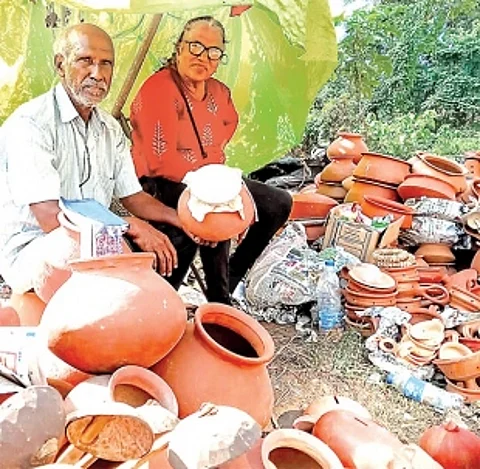

MARGAO: Jose Rodrigues, a 73-year-old resident of Vaddem, Sucorro, is a third-generation potter, continuing the legacy that his family has upheld for decades. From the age of 24, Jose has dedicated himself to the art of pottery, showcasing his craftsmanship each year at the feasts celebrated at the Holy Spirit Church in Margao. Last December, during the feast of Our Lady of the Immaculate Conception, visitors to the fair would have likely encountered the Rodrigues duo, Jose and his wife Lia. In conversation with José, he listed the traditional earthenware utensils once crafted, including Dhonn (Vail), Kodem, Kunne, Bhudkullo, Kolso, Malti, Damne, Lavni, Miller, Tizal, Copro, Forn, Kombo, Thovo, and more.
However, many of these utensils are no longer
produced due to dwindling expertise and demand. José notes that in addition to utensils, they now also create decorative art and glazed pottery. “Traditionally, I used a manual wheel for crafting, but now I use an electric wheel, which
requires less effort,” says José. He further adds, “One of my two children is very
passionate about pottery, and I am delighted about that.”
“Today, improvements in transportation have significantly eased our lives. In the past, without motor vehicles, we transported our pots to different locations for village fairs via bullock cart or boat (Taar),” says Rodrigues. “We used to visit places like Curtorim, Loutolim, Raia, and Old Goa, which was our ‘must-go’ destination. In those days, we cooked on-site, but now we eat out.” Rodrigues informs that their family operates a permanent stall at the market in Mapusa.
“The work we undertake
is painstaking, time-consuming, and tiring. We do not use moulds; everything is moulded manually by hand,” he explains. Some challenges the family faces include sourcing firewood and labour, which is mostly non-local nowadays.
Despite a decline in demand among the general public, there is an increased demand
for earthen utensils in the hotel industry.
Regrettably, these utensils are often used for purposes they were not intended for, leading to misconceptions about their use. For example, a pot meant for cooking is now used to serve food on banquet tables. With a smile, Rodrigues mentions that people from Bardez generally prefer earthenware made of red mud. He recalls that prices of a small ‘Kunne’ were around 3-4 paise some 45 years ago, while the same piece costs Rs 150-200 today. Firing terracotta is a lengthy process, taking around 3-4 days, he explains.
The potter community strictly married within their clan, spread across places like São José de Áreal, Sarzora, Verna, Duler (Mapusa), Anjuna, and Calapor (Merces). “We take pride in who we are!” he exclaims. “Apart from selling our goods for feasts, we used to walk with a basket on our heads to places like Salvador do Mundo, Pilerne, and Reis Magos (Verem). My late brother-in-law, Zuzu Sequeira, was an expert in crafting percussion instruments like Ghumot and Madlem, as well as high-quality alcohol distillation assembly units,” adds Jose.